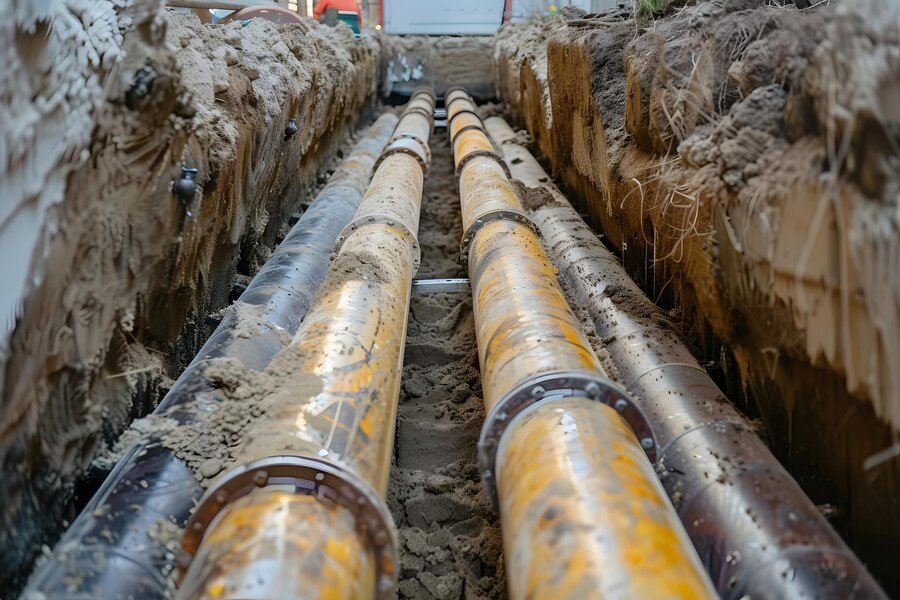Underground gas piping is critical in delivering natural gas to homes, businesses, and industrial facilities. It ensures a safe, reliable gas flow for heating, cooking, and powering various appliances. In this guide, we’ll explore what underground gas piping is, why it’s essential, and how it benefits the modern energy system.
What is Underground Gas Piping?
Underground gas piping refers to a network of pipes buried beneath the ground that transports natural gas from the main gas line to buildings. This system keeps the gas supply secure, shielding it from external damage and weather-related risks. The pipes are usually made from strong materials like steel or plastic to stop leaks and last a long time.
Why Is Underground Gas Piping Important?
Underground piping systems are essential for several reasons:
- Safety: Keeping gas lines underground protects them from damage caused by weather, accidents, or vandalism. This minimizes the risk of dangerous gas leaks or explosions.
- Durability: Buried pipes are less exposed to wear and tear, which helps them last longer. Steel and plastic are popular materials because they don’t rust or break easily.
- Efficiency: Underground piping systems provide an efficient way to transport gas, reducing the energy needed to push gas through pipes. This helps to lower the overall cost of energy delivery.
- Aesthetic Appeal: Having pipes underground improves the appearance of neighborhoods and industrial areas. It keeps the landscape clear, avoiding the clutter of overhead lines.
Materials Used in Underground Gas Piping
The materials used in underground gas piping must be strong, flexible, and resistant to the harsh conditions underground. Two of the most common materials are:
- Steel: Steel pipes have been used for decades due to their strength and durability. However, they require a protective coating to prevent rust.
- Polyethylene (PE): PE pipes are lightweight, flexible, and resistant to corrosion. People like to use them instead of steel for homes and businesses because they are easy to take care of.
Both materials have their benefits, and picking the right one depends on where it is, the type of soil, and the kind of gas being moved.
Installation of Underground Piping
Proper installation of underground \piping is crucial to ensure safety and efficiency. Only licensed professionals can install gas pipes, and they must follow important safety rules. This includes:
- Proper Depth: The pipes must be buried at a sufficient depth to avoid damage from digging or construction activities. Typically, they are placed 18 to 24 inches below the surface.
- Leak Detection Systems: Many systems include features that help detect leaks early, preventing dangerous gas build-up.
- Regular Inspections: Regular checks and maintenance are essential to ensure that the pipes remain in good condition and meet safety standards.
Regulations and Safety Standards
Rules are in place to make sure that putting in and taking care of underground pipes keeps people and the environment safe. The Canadian Standards Association (CSA) sets the rules for natural gas piping systems in Canada. Compliance with these standards is mandatory for any company installing or maintaining underground gas pipes.
Professionals installing the pipes must be certified and follow the guidelines, including testing the system for leaks before it goes into service. Regular inspections ensure the system remains safe and efficient over time.
Benefits of Underground Piping
There are several advantages to using underground piping, including:
- Improved Safety: Keeping gas lines underground reduces the risk of accidental damage from external factors like storms or construction work.
- Lower Maintenance: Underground pipes are safe from things in the environment that can hurt them, which means they need fewer repairs and cost less to take care of over time.
- Energy Efficiency: The underground system saves more energy because the gas can flow without being affected by outside things like changing temperatures.
- Enhanced Property Value: Homes and businesses that use underground piping often see an increase in property value due to the reliable and clean energy source.
Common Uses of Underground Gas Piping
People often use underground gas pipes in:
- Residential Homes: For heating systems, cooking, and powering gas-powered appliances.
- Commercial Buildings: Providing energy for large-scale heating, cooking, or industrial processes.
- Industrial Sites: Supplying natural gas to factories and other facilities where large amounts of energy are required.
How to Maintain Your Underground Gas Piping System
Maintenance is key to ensuring your underground gas piping remains in good working condition. Here are some simple tips for homeowners and businesses:
- Regular Inspections: Schedule professional inspections to check for leaks, corrosion, or other potential issues.
- Know the Signs of a Leak: If you smell gas or notice dead vegetation around the piping area, it could indicate a leak. Contact a professional immediately.
- Mark Your Pipelines: Always know where your underground pipes are located. Before digging or doing construction work, call your gas company to mark the area to avoid accidental damage.
Conclusion: Ensuring Safety with Professional Installation and Maintenance
Underground gas piping is an essential part of the energy infrastructure that keeps homes and businesses powered efficiently and safely. Its installation and maintenance require professional knowledge and adherence to safety standards.
If you live in Alberta, G & R Insulating offers reliable gas piping services. They are good at putting in underground pipes, so your system is safe and follows all the rules. Contact them today to learn more about their services and how they can help protect your property with safe underground gas piping.




